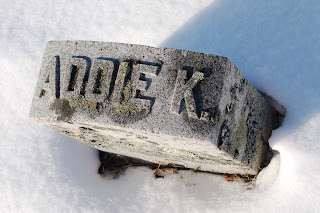In the 21st century, clinicians know typhoid fever and malaria as two distinct diseases. However, in the 19th century, even experienced physicians may have been unable to to distinguish between them. When a doctor couldn't determine, the "catch all" diagnosis, "typhoidmalarial fever" was often used. This was the case in the death of great grandmother Addie K Johnson.
Addie K Johnson married John Mylott in Whitehall New York on the 15th of February 1882. Their marriage did not make its sixth anniversary because Addie Johnson died on New Year's Day 1888 on a canal boat docked in the Atlantic Basin in Brooklyn, New York. John Mylott was a Champlain canalman and navigated the water from New York Harbor to the St. Lawrence. Addie and John had several children in that short time: Walter Robert Mylott 1882-1934, Milo Benjamin Mylott 1884- 1937, George Leslie Mylott 1887-1964 and possibly an infant, Eleanor 188?-188?.
The Atlantic Boat Basin in Brooklyn where Champlain Canal
boats docked while in New York Harbor
It was customary for the wife and kids to live aboard in canaling season. So John, Addie, Walter, Benjamin, Leslie and Eleanor were, no doubt, all aboard the canal boat on many trips. December was late in the season to be traveling the Champlain canal and Hudson River and perhaps in 1887, the ice had not yet formed on the river so they made the trip to New York City with some cargo. Then something went wrong because on December 10th,1887 a doctor began attending Addie while the boat was docked in the Atlantic Basin in Brooklyn. Twenty one days later, in the early morning hours of New Year's Day 1888, the young mother was dead on the family's canal boat.

Cause of Death:
TyphoMalarial Fever
Meningitis and Convulsions
click on image for more detail



In the 21st century, there is no such diagnosis called TyphoMalarial Fever. Some of the credit in determining the fact that these are two separate diagnoses - before the advantage of modern microbiology and laboratory techniques, goes to the father of modern medicine, William Osler. A Canadian physician, Osler practiced in Montreal and later Baltimore where he was one of the four founders of John Hopkins Medical School. His famous contribution to medical literature, "The Principles and Practice of Medicine", a classic blend of keen observation, listening to complaints of patients, clinical experience was published four years after Addie K's death. Below is an abstract of a paper written in 2004 firmly giving Osler credit for his keen ability to differentiate typhoid from malaria.
Infectious Disease Clinics of North America: 2004 Mar;18(1):111-25.
Osler on typhoid fever: differentiating typhoid from typhus and malaria.
Cunha BA..
Early in the history of medicine, physician had a difficult time differentiating acute febrile illnesses without localizing signs. Typhoid fever and malaria share common features, which caused diagnostic problems during the 1800s. Physician even introduced a new term, typho-malaria, a testimony to their diagnostic confusion. Osler, consummate clinician and careful observer, had vast experience with typhoid fever and malaria. He was able to easily discern between the key features of both of these infections. He also relied on fever patterns to clearly differentiate typhoid fever from malaria. Osler is credited for debunking the term typho-malaria. His clinical description of typhoid fever remains unsurpassed. Clinicians still can benefit greatly from reading Osler's clinical description of typhoid fever.
On a personal note, I doubt great grandmother Addie K. died from malarial in the midst of winter in New York City. The 1887-1888 winter, by all accounts, was unusually cold and later produced the "The Great White Blizzard of 1888" on the east coast and "The Children's Blizzard of 1888" in the upper mid west. Addie K's death certificate states the doctor began caring for her on December 10th. Malaria in New York City in December? It is much more likely Addie succumbed to typhoid due to using water for cooking and drinking directly from the Hudson River while navigating to New York City or while docked in the Atlantic boat basin. Sewerage into the river ran freely from the cities along the river - Troy, Albany, Kingston, Newburgh, Yonkers and Manhattan. Sanitation on barge boats was not treated and went directly into the waters and if Addie used a bucket dipped into the river water for her cooking, there was a good chance the culprit was typhoid.
There is one other possibility and that is that the death certificate is completely wrong. There is some evidence that Addie had an infant girl, Eleanor at the time of her death. Perhaps, the cause of death was puerperal fever, an infection after childbirth. We will never know.
Today, due to modern sanitation, hand washing, and a typhoid vaccination, typhoid fever and puerperal fever are infrequent.

The Lancet, 2002 Oct 26;360(9342):1339.
Addie K's body was returned to Whitehall and she is buried with her family in the North Granville Cemetery along NY route 22.




















































